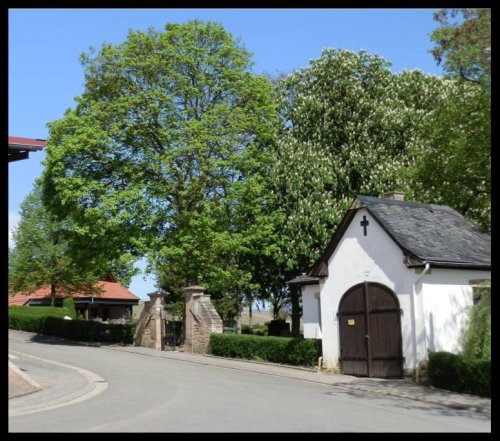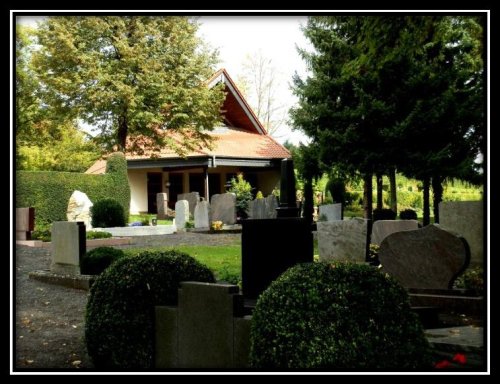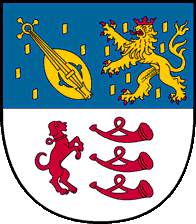Tour of Spiesheim's History
Graveyard and Funerals

In many cultures, the graveyard with its graves as last resting place of the deceased is a space clearly separated from the world of the living. It enables the relatives to commemorate their deceased in peacefulness. In Germany, deceased and stillborn have to be buried at designated places.
The graveyard plays an important role in religious practice and meets public needs, too.
This social as well as religious significance of a graveyard has originated a variety of taboos, moral duties and laws. Offending the rules or desecrating the place is punished by the respective community. Disturbance of peace, desecration of corpses, defilement of graves and grave robbery are punishable in practically all cultures. Such actions are prosecuted in Germany.
During ancient times and the great migrations, the German tribes living in the territory of today's Germany cremated or buried their dead.
Cremation was prohibited with the spreading of Christianity. Following the history of Jesus Christ the faithful were buried. Only at the end of the 19th century cremations were allowed again.
In the Middle Ages, the burial of the deceased was very much characterised by the church. Usually, it took place on the day of death and under certain formalities that varied considerably depending on the status of the deceased: Ordinary people were buried without coffin, just lying on a board and given to earth in the clothes they had worn while dying. More distinguished people were buried in a coffin, sometimes made of stone until the 14th century. The deceased was carried to his grave by his relatives.
Medieval burial sites have not been preserved in Germany. Usually, and so in Spiesheim, too, they were situated round the Catholic Church, which is why another word for "graveyard - Friedhof" is "churchyard - Kirchhof" in German. Since the beginning of the 16th century, burial sites were moved to the outskirts of villages due to lack of space and danger of epidemic. This arrangement has been kept in many villages, which is also valid for the graveyard in Spiesheim opened in 1833.
From this time on, the deceased were put in a coffin in the house they had died and on the funeral day laid out on a bier in the yard. After the last blessing through the priest and possibly a farewell by the choir or band the coffin was put on the hearse. Decorated with flowers and wreaths, and, most of the time, accompanied by many mourners the funeral procession began to move. People from nearly every house "went with the procession". A horse covered with a black blanket drew the hearse to the graveyard.
Until the end of the late 1980s, the graves on the graveyard in Spiesheim were dug by hand, which was a very hard work, especially in winter when the soil was frozen.
Sliding soil caused by heavy rain often had to be removed from the grave. Sometimes the gravedigger was still looking out of the open grave when the funeral procession was already on its way to the last resting place.
After the deceased had been buried by the priest, maybe accompanied by a dirge or an instrumental piece, the requiem or funeral service at church followed, as is still customary. Afterwards, a contemplative funeral meal ("Leichenimbs") over coffee and cake was usually held in the house of the deceased in order to commemorate the deceased together and to help the bereaved family members getting over their grief. This custom of a funeral meal is still is use although it often takes place in a restaurant or the community centre nowadays.
Due to the increasing use of cars, horse-drawn hearses were superseded by funeral vans in 1965. The little house to shed the hearse standing on the right of the front of the graveyard still exists.


In 1988, the current funeral hall decorated with windows designed and made by Stefan Gassner ("glass artist" from Spiesheim) was opened and the area next to the building laid out as extension of the graveyard. At that time, the funeral processions starting from the home of the deceased came to an end.


Old tombstones dating from the early period of the graveyard were kept for a long time. During the last years, they had to be taken down either due to unsoundness or because no relatives remained to take care of them. So, sad to say, there are no more memorial stones left that date from that time. However, Ingolf Jung took at least some photos of several nice old tombstones, as shown here.
Since the rearrangement of the old burial ground and the part on the right side behind the entrance in 2015, rows for urns from cremations have been provided.

Text 26: Sigmund Jung October 2016
Translation: Hildegard Wingert
Pictures: Erich Dexheimer / Ingolf Jung

